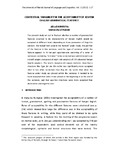| dc.contributor.author | Buregeya, Alfred | |
| dc.date.accessioned | 2015-06-17T08:02:04Z | |
| dc.date.available | 2015-06-17T08:02:04Z | |
| dc.date.issued | 2013 | |
| dc.identifier.citation | The University of Nairobi Journal of Language and Linguistics, vol. 4(2015). 103-116 | en_US |
| dc.identifier.uri | http://hdl.handle.net/11295/84973 | |
| dc.identifier.uri | https://linguistics.uonbi.ac.ke/basic-page/university-nairobi-journal-linguistics-and-languages | |
| dc.description.abstract | The present study set out to find out whether a number of grammatical
features assumed to be characteristic of Kenyan English would be
accepted at different levels depending on three parameters of linguistic
context: the lexical item used in the feature2 under study, the position
of the feature in the sentence, and the type of sentence which the
feature appears in. A two-part questionnaire consisting of a series of
sentences containing “mistakes” to be corrected was administered to an
overall sample (composed of eight sub-samples) of 218 educated Kenyan
English speakers. The results, based on chi-square statistics, show that a
structure like Type for me this letter was significantly more accepted
(that is less often corrected) than Buy for me lunch, that when the
feature under study was placed within the sentence it tended to be
more accepted than when it was placed at the beginning or at the end of
the sentence, and that question structures were more accepted than
declarative and negative ones. | en_US |
| dc.language.iso | en | en_US |
| dc.subject | University of Nairobi Journal of Linguistics and Languages | |
| dc.title | Contextual variability in the acceptability of Kenyan English grammatical features | en_US |
| dc.type | Article | en_US |
| dc.type.material | en_US | en_US |

